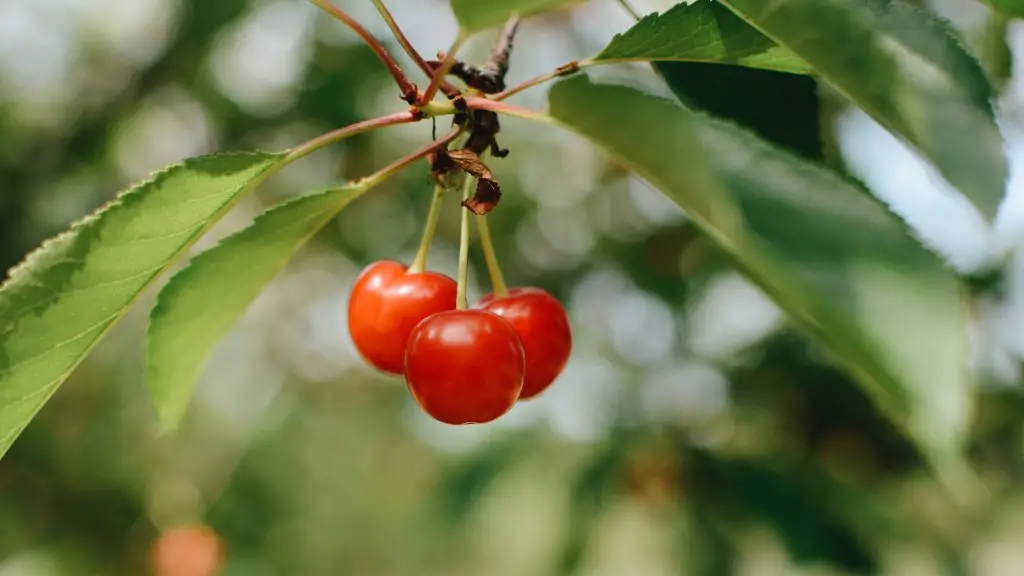Tree Pollination
The first step necessary to make a cherry tree fruit is understanding the basics of how to pollinate a tree. For a cherry tree to bear cherries, pollination must occur in two stages. Self-pollination, in which the tree transfers pollen from one flower to the same flower, requires the presence of both anthers and stamens. This is usually done with the aid of insects such as bees, but can also be achieved with a handheld brush. Additionally, cross-pollination occurs when the pollen from another cherry tree is transferred to a different cherry tree. In order for cross-pollination to be properly achieved, the tree must be present during the times when the tree flowers, and both trees must be compatible in terms of their species.
Tree Nutrition
Cherry trees, like any other fruit-bearing tree, needs to be properly nourished in order to produce fruit. The tree should be regularly fertilized – usually once per month – with an fertilizer that is rich in nitrogen, phosphorus, and potassium. Additionally, the soil where the tree is planted must be well-drained and receive ample sunlight. Furthermore, the tree should be pruned on a regular basis to ensure that the maximum amount of flowers and fruits can be produced.
Pest Control
The presence of pests can significantly reduce the amount of fruit that a cherry tree can produce. Regularly care for your cherry tree in order to reduce any chances of it becoming infested with pests. Some of the most common pests that attack cherry trees include aphids, mites, thrips, and fruit flies. Additionally, it is important to note that some species of birds, such as crows, can also be a threat to the tree’s production of fruit. You can protect your tree from these pests by regularly spraying an insecticide and by hanging bird deterrents from the tree.
Weather and Climate
The weather and climate of the area where the tree is planted can also affect the amount of fruits produced by the tree. If the temperatures of the area are extreme – either too hot or too cold – it may lead to a reduced number of fruits that can be harvested. Additionally, too much rainfall can further decrease the amount of fruits produced. As such, it is important to choose an area that receives ample sunlight and has a moderate climate.
Tree Variety
The variety of cherry tree that is chosen is also an important factor in determining the amount of fruit that is produced. Different varieties of cherry tree may require different pollination methods and may respond differently to the environment where they are planted. Some cherry varieties are easier to produce than others, and some may produce larger fruits then others. It is important to research the different cherry tree varieties in order to choose one that is best suited for the climate and environment of the area.
Harvesting
In order for a cherry tree to produce the desired amount of fruits, proper harvesting must be employed. As the fruits begin to ripen, it is important to monitor them closely and pick them as soon as they are ripe. For optimal freshness, it is best to pick each cherry individually. Additionally, it is important to discard any defective or damaged fruits, as they can reduce the overall quality of the harvest. Proper harvesting will ensure that the maximum amount of fruits is produced by the tree.
Pollination and Inbreeding
In order to ensure optimal fruit production, it is important to understand the fundamentals of inbreeding. Inbreeding is the process of breeding two individuals which are closely related. In the case of cherry trees, the inbreeding process should be done in order to make sure that the tree produces the same variety of fruit as the parent trees. This is done by pollinating two compatible cherry trees which are related by either cross-breeding or self-pollination.
Propagation
Propagation is another step that must be taken in order to make a cherry tree produce fruit. The propagation process involves taking a cutting from an existing cherry tree and planting it in a new area. In order for the process to be successful, the new area must have the same or an even more favorable climate for the cherry tree in order for it to have adequate growth and fruit production. Proper propagation techniques are important in order for the tree to bear the desired amount of fruit.
Biological Controls
In addition to more traditional approach to tree fruit production, such as fertilizers and insecticides, there are also some biological controls which can help reduce the amount of pests and diseases that the tree may be affected by. For example, the use of beneficial insects such as ladybugs and spiders can help reduce the amount of pest problems the tree has. Additionally, the use of beneficial fungi and bacteria can help the tree resist and combat certain diseases, such as fungal rot. By utilizing these biological controls, the amount of fruits produced by the tree can be significantly increased.
Fungal Disease Prevention
Fungal diseases such as mildew and leaf spot can also be a problem when attempting to make a cherry tree fruit. To combat these diseases, regular applications of fungicides can be used. Additionally, proper watering techniques can also help to reduce the risk of a fungal infection. Watering the tree at the base rather than the foliage can help reduce the chance of the fungus spreading. Additionally, removing any fallen leaves or fruits from the tree can help to reduce the chance of any diseases.
Soil Preparation
The soil in which the tree is planted must also be adequately prepared in order for the tree to bear fruit. The soil should be aerated in order to create a healthy environment for the tree’s roots to grow. Additionally, the soil should be rich in nutrients and free from any weeds. Adding some compost to the soil can help to improve fertility and drainage. Furthermore, it is important to make sure that there is not an excess of water in the soil, as this can lead to the tree becoming waterlogged and unable to produce the desired number of fruits.
Fruit Color
The color of the cherries produced by the tree can also have an effect on the amount of fruit it will produce. In general, dark red cherries are more preferred than lighter cherries, as they are seen as more desirable by consumers. Additionally, cherries which are light yellow or green are usually not seen as profitable and may not be purchased as often. Therefore, it is important to be aware of the color of the cherries that the tree is producing in order to make sure that the tree produces a desirable product.
Pruning
Pruning is another important step to make sure that the cherry tree produces the desired amount of fruit. Pruning the tree on a regular basis helps to reduce the amount of unproductive branches, and provides the tree with better sunlight and ventilation. Additionally, proper pruning can also help to shape the tree and remove any dead or diseased branches. Pruning should be done carefully, as it can lead to a decreased number of fruits if it is done improperly.



